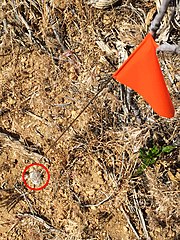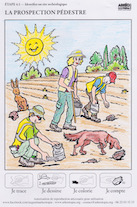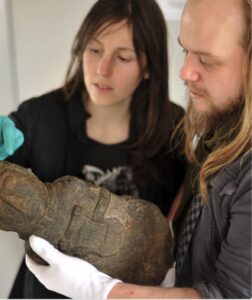Join Augustin, Alex, Lisa and the whole ArkeoTopia team to discover additional resources for step 2.2 in My Archaeology Book about how archaeologists determine the former presence of human beings using fieldwalking technique.
Step 2.2 – Locating Archaeological Remains
Fieldwalking
Corresponding pages in MAB1 and MAB2
MAB 1, p. 7 (step 4.1 on p. 10 in the 1st edition) and MAB 2, pp. 8-9
More about this step’s reference artifact
The longest silex blades that have been discovered to date are what decorate pages 8-9 of My Archaeology Book, titled Fieldwalking. These blades, measuring from 8.86 to 14.76 inches, were discovered using the fieldwalking method in the Grand Pressigny region of the Indre et Loire department (37) of France. Fieldwalking is the first ever technique used by archaeologists to locate ancient human settlements.
 The artifacts pictured here, named the blades “livre-de-beurre”, or pound of butter, are the largest known flint blades ever to have existed. Their name “livre-de-beurre” speaks to their interesting shape due to the lithic reduction technique used to make tools at the time of their fabrication.
The artifacts pictured here, named the blades “livre-de-beurre”, or pound of butter, are the largest known flint blades ever to have existed. Their name “livre-de-beurre” speaks to their interesting shape due to the lithic reduction technique used to make tools at the time of their fabrication.
This technique involves flaking off bits of stone from what is called the nucleus, or lithic core. In the case of the “livre de beurre” blades, these lithic flakes or debitage resemble the butter clumps used in the region during the19th century in terms of their color and shape.
This kind of debitage corresponds to a relatively short period of time between 2,800 and 2,450 BCE at the end of the Neolithic era. These large stone blades produced by master carvers have been found spreading from as far as the French Alps, up through Brittany and through the Netherlands. They were often modified into daggers, an object that was not exceptionally useful but instead signified the wealth and prestige of its owner. The Prehistory Museum in Grand-Pressigny is a leading resource for knowledge on the usage of these flints, as well as the first European trade networks.

 In contrast with accidental discoveries made by explorers, construction workers, local villagers or other untrained people, the field survey is a very purposeful endeavor. Archaeologists in the mid-twentieth century developed this rigorous method for exploring an area in a methodical and systematic way in order to reveal clues about ancient human occupations. There are several different ways in which the survey method can be applied. The oldest and least expensive way is fieldwalking, a non-destructive method that does not damage the archaeological remains in or on the ground. With this method, archaeologists that arrive on-site are not there to excavate, but instead to locate artifacts and clues on the surface of the ground that could be proof of a former human presence.
In contrast with accidental discoveries made by explorers, construction workers, local villagers or other untrained people, the field survey is a very purposeful endeavor. Archaeologists in the mid-twentieth century developed this rigorous method for exploring an area in a methodical and systematic way in order to reveal clues about ancient human occupations. There are several different ways in which the survey method can be applied. The oldest and least expensive way is fieldwalking, a non-destructive method that does not damage the archaeological remains in or on the ground. With this method, archaeologists that arrive on-site are not there to excavate, but instead to locate artifacts and clues on the surface of the ground that could be proof of a former human presence.
In the fieldwalking method, a team of archaeologists organize themselves either into rows (the oldest procedure) or in squares or other shapes that allow for the best ground coverage of the space to be surveyed, given the number of participants and the available equipment. Whatever shape is chosen the objective remains the same: to methodically survey the surface of the ground from one end to the other. Throughout their walkprosp, hence the name “fieldwalking“, the fieldwalkers scrutinize the slightest detail searching for clues that might indicate human beings had once lived on the site.
In the drawing, we see a team of five archaeologists: Lisa the director of ArkeoTopia’s mission, Alex who is Lisa’s colleague, Tom the archaeology student, Presto the hare, and Sniffer the dog. The team is looking for signs of human life from the end of the Neolithic era in a field in the Grand-Pressigny region. They are dressed for the occasion with headgear (a sunhat, a bucket hat a cap), walking shoes, and sturdy clothing with reflective stripes. As the director of the mission, Lisa was responsible for obtaining authorization in advance from the field owner as well as from the Regional Archaeology Service.
 In the image, Sniffer can be seen sniffing out a nucleus, or lithic core. Alex is picking up a magnificent “livre-de-beurre” flint blade, which he puts in a bag bearing the mission’s inventory number. He will need to indicate the location of the discovery and other relevant information in his notebook. While Tom has already found a blade that can be seen in his bag, he has also just spotted an end-scraper or scraper. Lisa uses her digging stick to check the ground without having to bend down, as well as a bucket to collect artifacts that don’t fit into the bags. Presto is disappointed that he has only found a flint nodule, which has no archaeological significance.
In the image, Sniffer can be seen sniffing out a nucleus, or lithic core. Alex is picking up a magnificent “livre-de-beurre” flint blade, which he puts in a bag bearing the mission’s inventory number. He will need to indicate the location of the discovery and other relevant information in his notebook. While Tom has already found a blade that can be seen in his bag, he has also just spotted an end-scraper or scraper. Lisa uses her digging stick to check the ground without having to bend down, as well as a bucket to collect artifacts that don’t fit into the bags. Presto is disappointed that he has only found a flint nodule, which has no archaeological significance.
Clues
The 11 clues include:
- The team of several archaeologists
- Their hats for sun protection
- The digging stick
- The bucket and plastic bags for collecting archaeological remains found on the ground’s surface
- The team’s walking shoes
- The team’s clothing with reflective strips
- Alex’s notebook
- Sniffer, the dog, who represents the ability to survey the ground
- Presto, the hare, who represents the ability to transmit information quickly
- The lined field, indicative of the type of area the team is surveying
- The flint remains spotting the field (blades, nucleus, end-scraper or scraper) indicating the former presence of human beings.
Using Ancient WritingsMy Archaeology Book
Resources HomepageStep 2.3 – Location
Via Satellite Imagery






